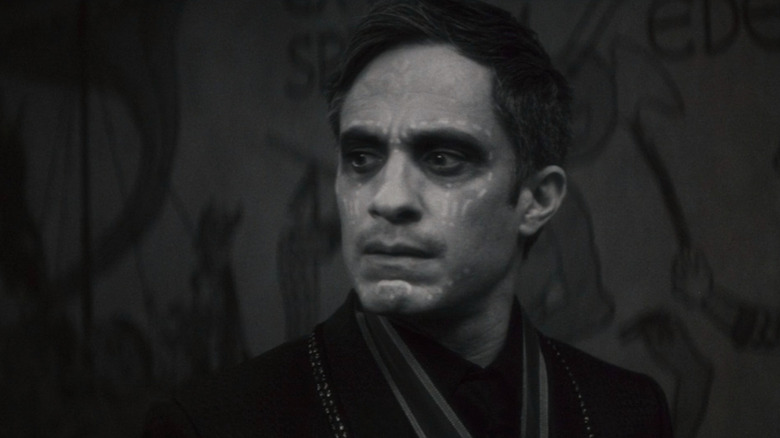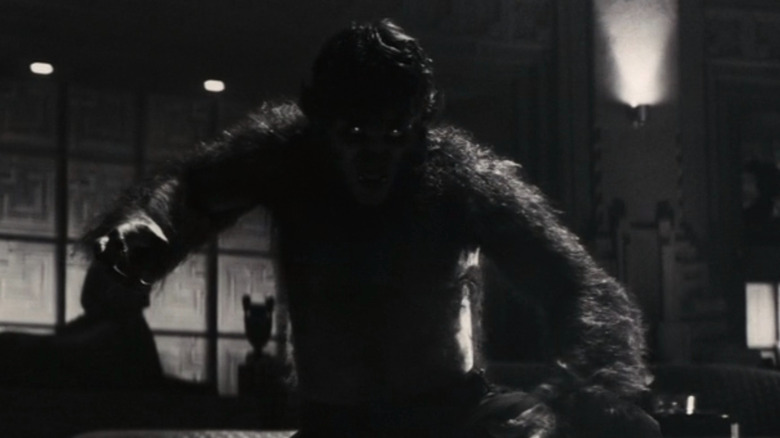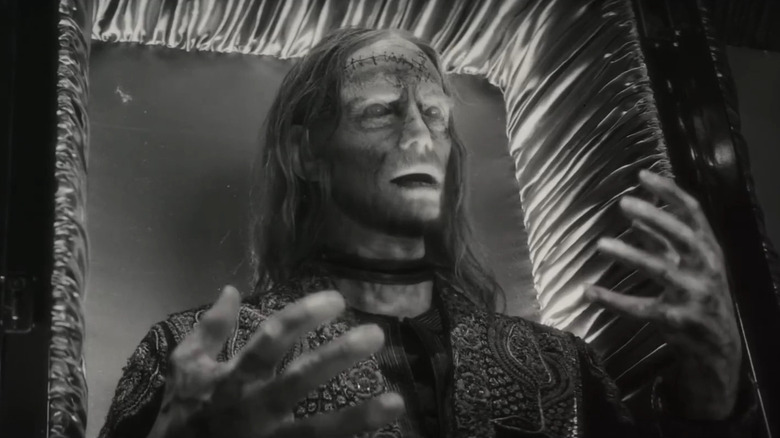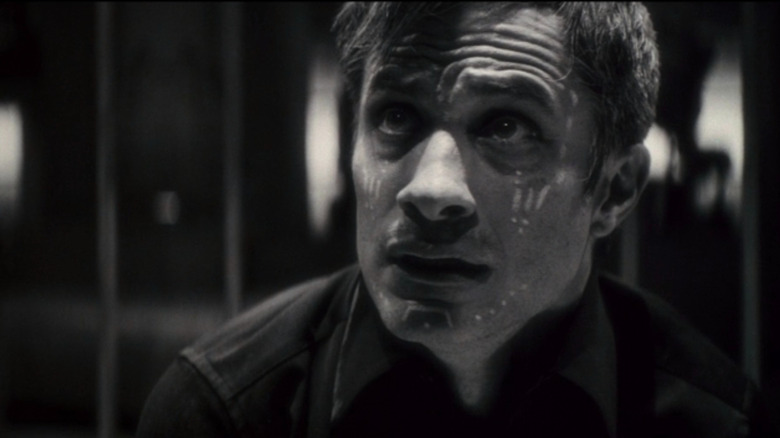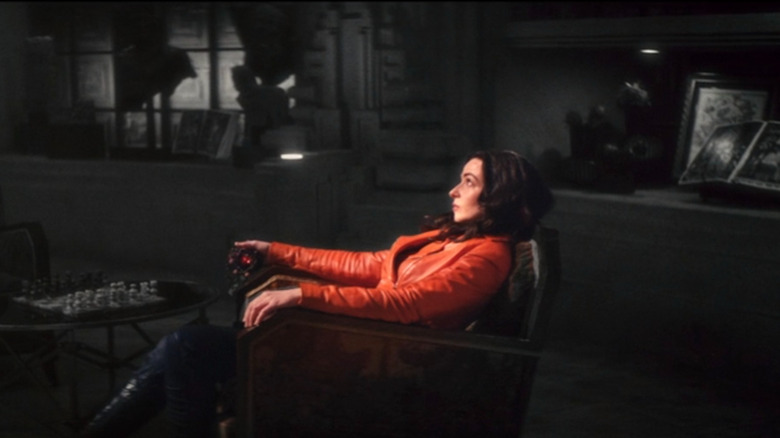Marvel's Kevin Feige Made The Final Call On A Key Aspect Of Werewolf By Night [Exclusive]
This article contains major spoilers for "Werewolf By Night"
In just under an hour, "Werewolf By Night" made me very excited for the future of monsters in the Marvel Cinematic Universe, while cementing itself as one of the coolest standalone projects from Marvel Studios. Composer Michael Giacchino ("The Batman") may provide the dark and whimsical sound of this Halloween special, but it's his sharp direction that shows a debut filmmaker who is only getting started.
"Werewolf By Night" is a gloriously gothic ode to the Classic Universal Monsters, Hammer horror, and "The Twilight Zone" that I never wanted to end. Giacchino spoke to my monster-loving heart with his insistence on keeping the titular monster as practical as possible.
A significant portion of the MCU often takes what should be an image that pops, and dilutes the color to the point where it looks like wet concrete sloshed all over the frame. "Werewolf By Night," however, is largely absent of color by design, and all the better for it. I have no doubt Giacchino could have made it work with more striking colors, but what we end up getting is one of the most visually striking Marvel projects to date.
Giacchino deserves credit for the black-and-white aesthetic, but the decision to release as such ultimately landed in the hands of Marvel Studios CEO Kevin Feige.
Feige ultimately landed on the black and white presentation
In an exclusive interview with /Film's Jack Giorux, Giacchino talks about how he had always envisioned "Werewolf By Night" in black and white. When Feige saw the footage back for himself, he agreed it was the only way to go:
"We came at it with the attitude that, nope, it's going to be in black and white, even if we don't know if it is or not, we're thinking it's going to be. When Kevin saw it in black and white, he turned to me and he said, "I guess this needs to be in black and white, doesn't it?" And I was like, "Yes, yes, yes, it does.'"
It would have been more concerning if "Werewolf By Night" was primed as Marvel's first foray with black and white. It's sad to think about, but some people bafflingly won't watch something because it's not in color. They had to have thought about whether younger audiences, despite the violence, would be turned off by that minute detail
Thankfully, the MCU has already proven the success of black-and-white projects with the first two episodes of "Wandavision." In both cases, the stylistic choice is vital to the heart of their respective stories.
"Wandavision" starts in this visual manner as a means to evoke the classic sitcoms of the '50s and '60s, while "Werewolf By Night" wants to make you feel as if you're watching a classic monster movie from the '30s and '40s.
Giacchino already shot most of the special in black and white
As it would turn out, Giacchino, in tandem with cinematographer Zoë White, had pre-planned shooting "Werewolf By Night" in black and white before Feige gave the final green light. The composer-turned-filmmaker saw the stylistic choice as a great opportunity to reflect Jack's grief. "It looks beautiful in color, but to me, there was something that was sadder about the black and white, something that brought me in more," says Giacchino.
While a cool aesthetic choice, shooting in black and white isn't quite as easy as you would think. You can always attempt to change the color levels in post, but as Giacchino will tell you, if you don't capture the right amount of light needed, the image falls apart (via /Film):
"We hedged our bets and we set up monitors that were black and white only monitors so that way I could make sure that what we were shooting lighting-wise was going to work. We knew the color was going to be fine, but I wanted to be assured that if we were lucky enough to do it in black and white, we would have what we needed. Converting later and trying to make the lighting right later, that's impossible and it's a big pain."
You get a glimpse at the end of what the costumes had to look like in order to pop. The crimson lining of Jack's cloak, in tandem with Elsa's red leather jacket, makes for a vivid image during the transition to color that evokes "The Wizard of Oz."
But "Werewolf By Night" going black and white holds another significance beyond an aesthetic flourish.
The absence of color sold Jack's loneliness and depression
One aspect of "Werewolf By Night" that really struck me was how surprisingly somber it is. "A lot of discussions were like, look, I really want to explore this idea of depression, says Giacchino. You're presented with a man devoted to empathy, who grapples with a curse that gets in the way of the people closest to him. It's one thing to go rescue his best friend, it's another to hide your true form in a room full of people who would slay you at a moment's notice.
Even with all of the bloody Werewolf action, some of the special's greatest moments are the reflective conversations between Jack and Elsa. His emotional tie with her is as strong, if not more so, than his bond with Man-Thing. A family man is the last thing you would expect out of a Werewolf, but Giacchino sees Jack as exactly that (via /Film):
"Jack, his speech about family is that there are all kinds of families in the world. And that the one thing that does connect us all is we all have some sort of family. And that family can be a blood family, it can be friendships, it can be all kinds of things. And so again, the fact that he's not going to abandon that family, that's a big deal and that's a big selling point for me in these characters is that they actually care about each other."
I loved seeing Elsa silently terrified of the fate awaiting her in the cage, while Jack attempts to connect with her on a human level before the big monster show. He's the snarling hairy beast, but it's clear who the real monsters in the room are.
Elsa's colorful transformation signals a better future ahead
While shooting in black and white makes "Werewolf By Night" stand out from the rest of the Marvel pack, the use of color is arguably just as important. The first one off the bat is the glowing red Bloodstone, which is often the center of attention whenever it's on screen. The other instance comes in the final few moments.
Now that Elsa is in control of the Bloodstone, she symbolically uses it to create a brighter picture on the horizon. The gentle cue of Judy Garland singing "Somewhere Over the Rainbow" slips in as she's illuminated in a red, not unlike the vivid glow of the ruby slippers (via /Film):
"The nightmare is over. She's going to leave that behind. I don't know what she's going to do with it, I don't know where she's going, but I know that the road is open for her now. I felt going into color was the best way to show that things are now changing and evolving and hopefully the future will be a brighter place."
Much like Jack, Elsa arrives at the Bloodstone compound with an ulterior motive. After all, she's the outcast who left her toxic family behind. "I think her coming here was a brave act to try and shed herself of all of that and start something new and begin a new path forward," says Giacchino. It may not be as drastic as performing a rescue mission for a sentient swamp monster that goes by the name of Ted, but is still poignant nonetheless.
"Werewolf By Night" is currently streaming on Disney+.
